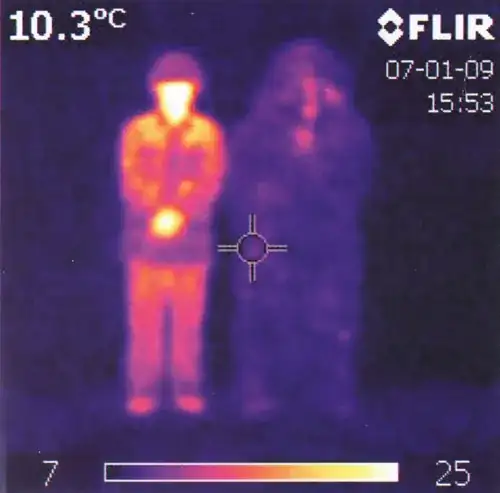No, it is not possible to hide a person's heat signature indefinitely. Even with the best suit imaginable, you will eventually either begin leaking the heat, overheating the person, or both.
One problem is that there are no perfect thermal insulators. This means that you must either use the best available and keep emissions below some threshold of detection, or you must use active cooling of the surface of the suit (think heat pumps dumping heat inward) to hide. Both will eventually increase the internal temperature until something (quite likely the wearer of the suit) undergoes some form of thermal failure.
With that said, you can do tricks to hide thermal signatures better.
One trick is to create some kind of internal heat sink -- think of is as sort of a "cold battery," e.g. a block of ice -- that can extend your total time before heat failure happens. It can be bulky, but if done right, you can get very good hiding for a while.
The second trick is to convert the heat and radiate in some fashion that, at least for the target use, is hard to detect. One example (not necessarily a very practical one) would be to attach a highly efficient laser to the top of the suite and send heat off in the form of a very closely controlled laser beam, presumably at some frequency unlikely to be detected, and with careful aim to avoid hitting detectors.
There are all sorts of variants of that last idea. One amusing one would be "heat eggs" that you could drop as you go. At first they would look cool, but then the interior high heat that they have stashed away would start to show. The trouble with that idea is that you'd end up setting a trail of bread crumbs to the user!
If you want to get really exotic, you could in principle try to figure out a way to radiate heat in some extremely hard-to-detect form such as neutrinos. If you could use particles that hard to detect to radiate heat, the result would be pretty close to the ultimate "true stealth" heat suit.
2014-10-25.0841 EST - Addendum
First, @ThomasPornin pointed out in the comments that Kim Stanley Robinson used the heat egg idea in his Mars series, which I've read and clearly (if unconsciously) must have picked up the idea. A truly amazing bit of hard science fiction, that series!
Second, there are a few more ways to dump energy than vibrations (heat and sound), electromagnetic (light in all forms), or matter dumps (which would include both neutrinos and heat eggs). You could in principle at least also use fields, including magnetic, electric, and potentially even gravity. (The strong and weak forces are too short range for dumping.)
Magnetic induction comes to mind as the most plausible, since you can come up with real scenarios of energy transfer with that one, even if they would be hard to use in most field situations.
Electric fields are... an interesting possibility, but pretty hard to quantify? I'm thinking of something akin to stranger version of a Wimshurst machine for inducing high electric charges (and thus dumping energy) to nearby objects. Weird, not necessarily very stealth, but at least possible in principle.
Finally, the ultimate suit-internal heat sink is one for which I am aware of exactly zero plausible supporting pathways: Endothermic nuclear, the nuclear equivalent of those instant cold packs used in sports (please see @RobJeffries excellent comment below on that point). If you can imagine some perfect process that gathers all the excess heat and "somehow" converts it without any major losses into the splitting of helium-3 nuclei into protons and deuterons, you have the idea.


